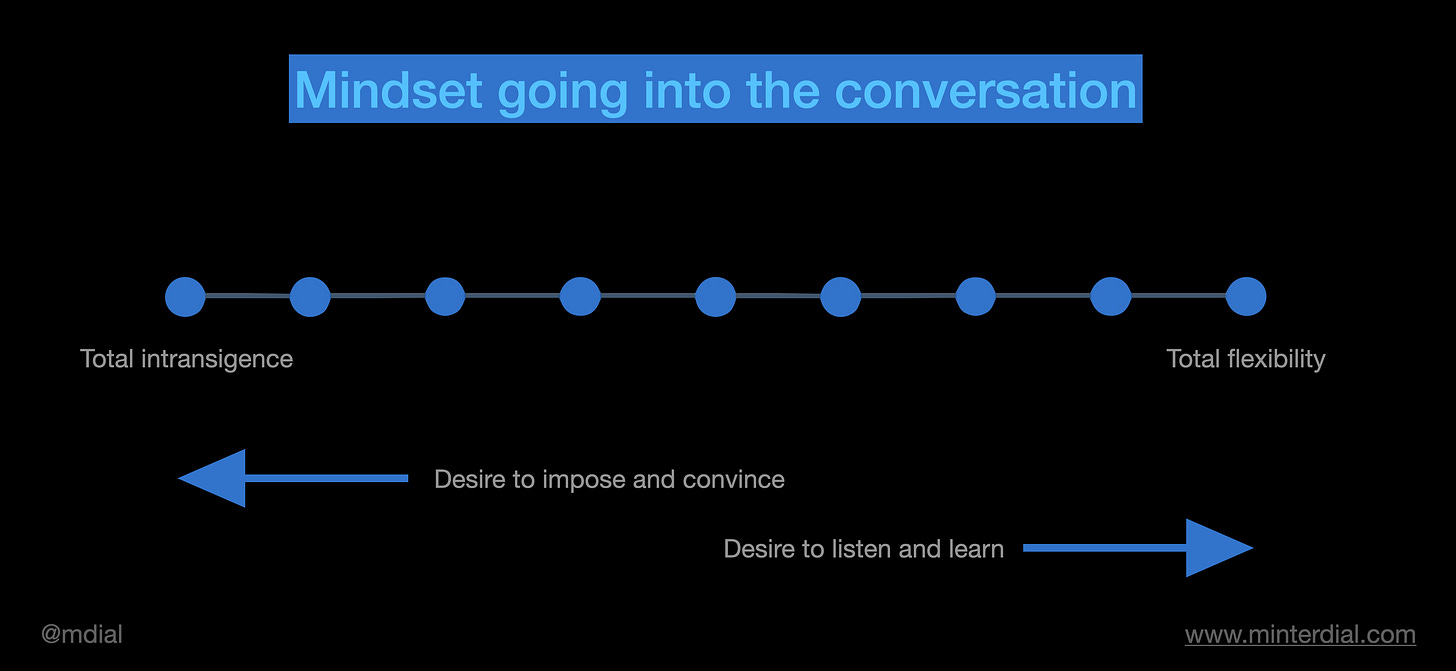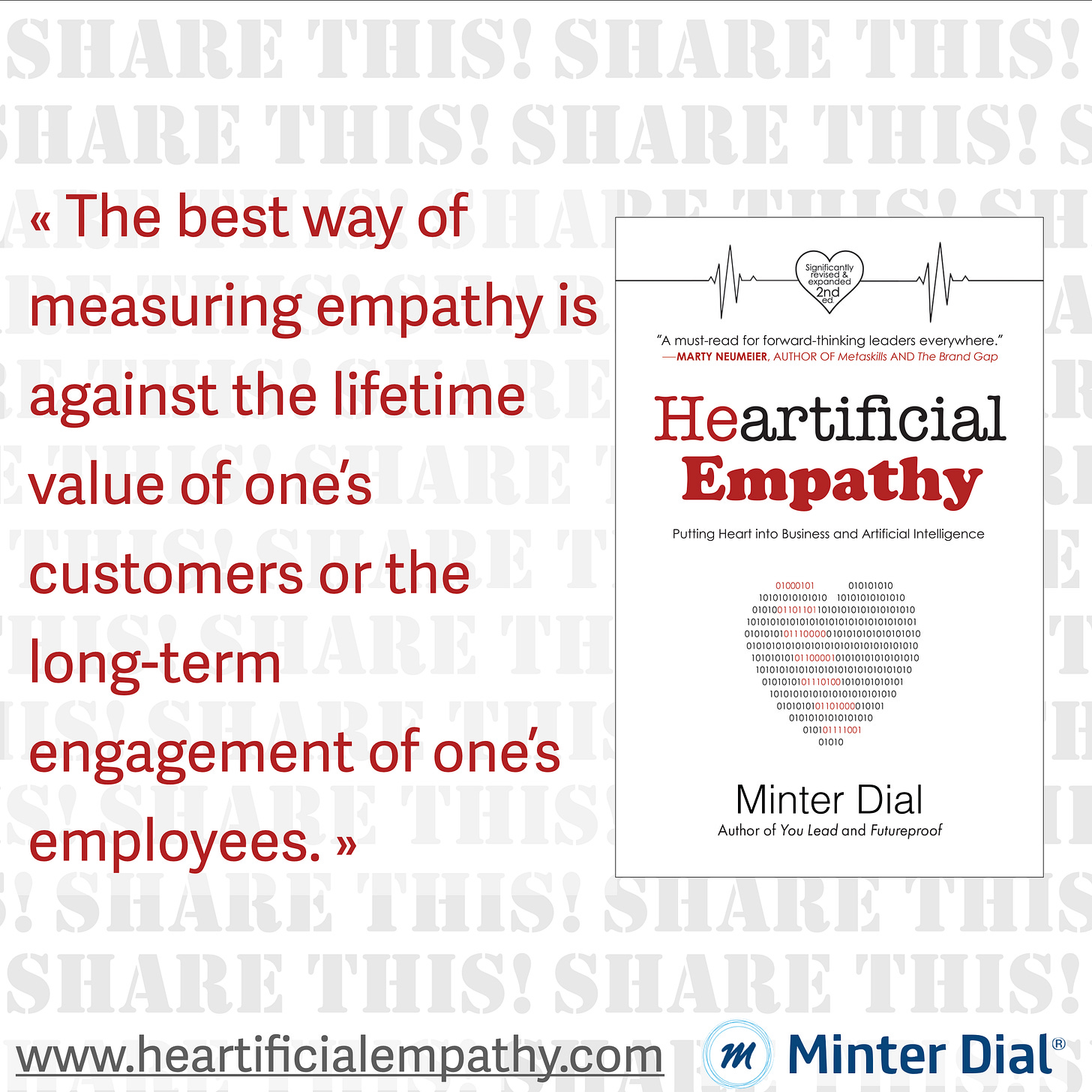How to hold an empathic conversation with someone who has an opposing point of view?
If you wish to be empathic, even over a contested topic, there are some key principles to keep in mind
I don’t know about you, but I can sometimes get caught up in a testy conversation without even realizing it. Writing about and practicing empathy is a 24/7 process, a little like life itself. There are ups and downs. There are times when you are more up to the task than others. Bringing empathy into any conversation, at least for me, is an active principle. In other words, it doesn’t come naturally. I need to reflect on the situation and rein myself in, in order to focus better on the individual in front of me. Thus, it occured to me that it might be interesting to define what it means to hold an empathic conversation. For starters, there are many forms of conversations. For example, it could be the short exchange you might have with a cashier or the first greeting in the morning with your partner. Even in these less consequential encounters, empathy can be most pertinent. But what of holding a longer conversation with someone, friend or stranger, on a topic that is not banal and where the other person holds an opposing point of view? This requires a more concerted effort, in that it requires self-monitoring, deep listening and keeping a meta perspective.
1+1 = …
One of the key ideas I’ve learned about in the development of Dialogos has been the idea of thinking about ‘us’ when considering a conversation with another. In other words, how can one person speaking to another create a third and ideally superior presence. The other consideration — or paradox — is the need to balance your willingness to listen and learn, and having the flexibility to change your own mind, versus having a conviction, owning a coherent and congruent point of view that you feel the urge to defend. As Rae Shanahan said to me in my podcast interview with her, it’s about holding your ideas lightly. Yes, to sticking to your guns, but with the understanding that you can also let them go, too. The crux of the concept is knowing which are non-negotiables, and why they are such for you. There is a useful nuance or scale to check in with that has, on one end, your level of conviction and/or intransigence about your beliefs, and on the other, your willingness to learn and change your mind. As a frame of reference, where do you sit before you head into the conversation?
The more to the left of the scale, the more difficult it will be to have an authentically empathic conversation. The further to the left one is, the more the reason for listening is oriented toward rebuttal, reframing and convincing. Of course, if you are off the scale flexible (on the right), you hold no conviction. The question then becomes about the manner (integrity, thoroughness) in which you come to your own conclusions and beliefs.
How to evaluate empathy?
As we continue to explore the notion of having an empathic conversation, it is crucial to come to an understanding of how we might evaluate empathy, beyond merely subjective and potentially vague parameters. It is important to distinguish between the emission and reception of empathy. Specifically, on the one hand, there is the empathy quotient that is embedded in the listener and his/her intentions. This means that, for anyone or any business wishing to be empathic, it’s about one’s effort and purpose, in abstraction, to some degree, of the amount of empathy that is explicitly felt by the target. In other words, a marketing team that conceives and designs a shampoo bottle that doesn’t slip through a soapy hand in the shower may require a certain amount of empathy that the person in the shower doesn’t necessarily — or at least explicitly — notice. Yet, empathy was being deployed. On the other hand, there is the receptor of empathy. To what extent does the ‘target’ of the empathy believe you were being empathic? This is the scoring that most people tend to focus on, but here there are no concrete ways to measure on any absolute scale. CVS reportedly used a simple survey that asked customers in their stores to what extent they felt that they were treated with empathy during their visit. Since there are many (often wrong) interpretations of what empathy actually is, this type of survey cannot be taken at face value. What matters here is the trend over time and how/what CVS does with the information! At least for a business, when inserting empathy into the design process, there is a way to gauge the success through customer satisfaction and sales numbers, even if empathy isn’t directly being scored. Of course, there are many components that go into that scoring, hence the opacity or challenge of measuring empathy in any isolated manner. Another important point is to make sure that your internal culture is coherent with your customer-facing external communications. As I wrote in Heartificial Empathy, the best way to measure empathy (in business) is against the life-time value of one’s customers or the long-term engagement of one’s employees.
Context
The context within which the conversation is being held counts quite a lot, in that it can determine the ambiance. It will certainly have an impact on your level of concentration, your ability to hear well, the types of distractions that surround you (e.g. your mobile phone, children playing, public space) and, lastly, the sense of confidentiality. Before diving into any meaningful conversation, one must be cognizant of the context. This also includes two other important factors:
To what extent are you yourself present? What is your anxiety or stress level? How comfortable are you?
How much time do you (both) have for the conversation? Is there a hard close and what is the event following (i.e. to what extent might that event contaminate your ability to be present throughout the entire conversation)?
The first point is critical because if you don’t check in with yourself, you will have difficulty regulating your emotions, ego and listening. For the second point, having (or giving the) time means that neither person is feeling the urgency of pushing in all his/her thoughts. When an interview or conversation is time-constrained, it becomes more about driving one’s talking points, which will impinge on the free and genuine exchange of points of view.
Attitude
Having checked in with yourself, the next component is evaluating your own attitude/mindset. What is your genuine intention in this conversation? Do you legitimately have interest in listening to what the other person believes? Do you have curiosity about how that person came to hold his/her belief? Are you willing to listen without judgment? Are you able to listen without interrupting? And, here’s the big one: do you allow that you might be able to change your mind? Depending on the subject and person on hand, you’ll have different answers to these questions.
Empathy doesn’t mean being nice
If we’re exploring what constitutes an empathic conversation, it’s not to suggest that it should be a kumbaya-style of meeting. If you’re intention is to convince or win over the other, that’s an entirely different and legitimate starting point in a conversation. And yet, one must know that it’s possible to wish to convince someone AND have empathy. In fact, the more you understand where the other person is coming from, their context, what they’re feeling and thinking, the better equipped you’ll be to persuade them. Any negotiator will know this. Being empathic doesn’t necessarily mean being nice. It doesn’t mean being meek or giving in. Just like the idea of dissolving a heated exchange may be the best solution, just because you’re practicing empathy doesn’t mean you need to agree with one another.
An empathic conversation = you both feel heard
The real meaning of an empathic conversation is that both people feel heard and have a better understanding of the thoughts and feelings of the other. Just as the 100+ Empathy Circles in which I’ve participated, I’ve seen the power to bond despite our differences once we all feel heard. When you are reflecting back what you’ve heard, you might also, when appropriate, observe the emotions being shown as well.
Some guiding principles for an empathic conversation
In order to hold a conversation on a tricky topic that is not only empathic but effective, there are some key principles that should be shared between the two individuals. Ideally, this is something that can be explicitly shared. However, more likely, it must be implicit in the exchange.
Find a convenient and reasonably calm location.
Make sure that both parties have an extended period of time to hold a longer conversation.
Be self-aware. Check your state of mind in advance of the conversation. Consider to what extent and why you may have certain beliefs that are non-negotiable, and where you have the possibility of doubt.
An empathic conversation is a two-way exchange where both individuals are earnestly wishing to listen to and understand the other. If possible, render this explicit at the outset of the exchange.
Reformulation is important, at a minimum, when there is doubt in the understanding. That said, it’s useful to reformulate without judgment throughout the conversation, to stay with and delve deeper into the other’s train of thoughts. The idea of being an empathic listener is not to put the other person on the defensive.
Keep looking at the conversation as a partnership, where you both are committed to learning from one another.
Keep the language courteous at all times.
Watch out for words whose definition might be subject to misinterpretation.
Whenever you have agreements, note these out loud.
Agree to dissolve the conversation if it is going nowhere or becoming too heated.
An empathic conversation is a two-way exchange where both individuals are earnestly wishing to understand the other.





